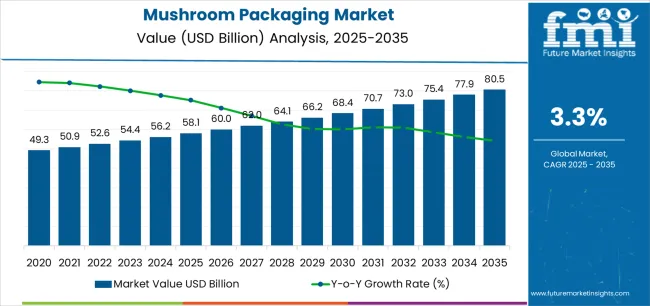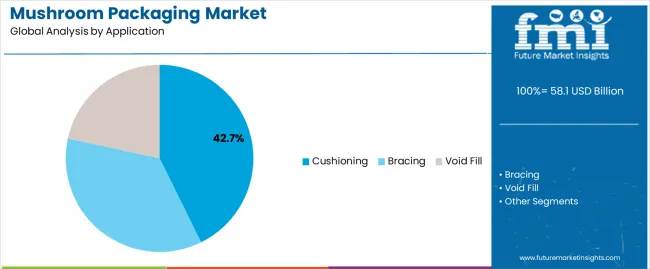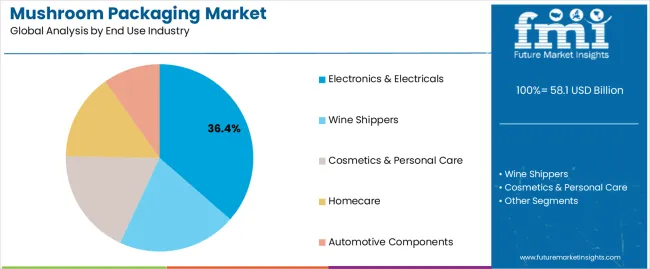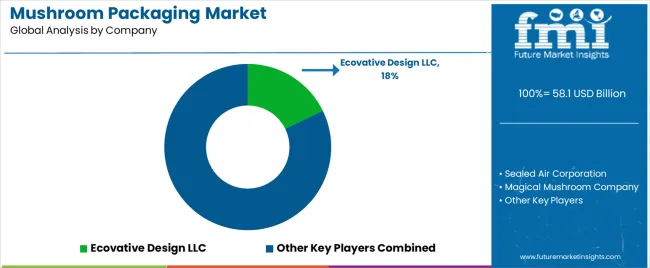The Mushroom Packaging Market is estimated to be valued at USD 58.1 billion in 2025 and is projected to reach USD 80.5 billion by 2035, registering a compound annual growth rate (CAGR) of 3.3% over the forecast period.
The mushroom packaging market is expanding steadily due to increasing global emphasis on sustainable materials and the replacement of synthetic plastics with biodegradable alternatives. Growth is being supported by regulatory initiatives promoting eco-friendly packaging solutions and rising corporate sustainability commitments across manufacturing sectors. Current demand is being driven by the versatility of mushroom-based materials, which offer high cushioning efficiency, compostability, and cost competitiveness compared to petroleum-derived foams.
Market participants are focusing on scaling production capacity, improving material consistency, and enhancing durability through process innovation. The future outlook remains optimistic as technological advances in mycelium cultivation and composite formulations continue to improve performance characteristics.
Growth rationale is based on the rising consumer and industrial preference for circular economy solutions, alignment with environmental compliance frameworks, and expanding adoption across industries such as electronics, consumer goods, and e-commerce These factors are collectively positioning mushroom packaging as a viable, sustainable, and scalable alternative within the global packaging ecosystem.

| Metric | Value |
|---|---|
| Mushroom Packaging Market Estimated Value in (2025 E) | USD 58.1 billion |
| Mushroom Packaging Market Forecast Value in (2035 F) | USD 80.5 billion |
| Forecast CAGR (2025 to 2035) | 3.3% |
The market is segmented by Application and End Use Industry and region. By Application, the market is divided into Cushioning, Bracing, and Void Fill. In terms of End Use Industry, the market is classified into Electronics & Electricals, Wine Shippers, Cosmetics & Personal Care, Homecare, and Automotive Components. Regionally, the market is classified into North America, Latin America, Western Europe, Eastern Europe, Balkan & Baltic Countries, Russia & Belarus, Central Asia, East Asia, South Asia & Pacific, and the Middle East & Africa.

The cushioning segment, accounting for 42.70% of the application category, has been leading due to its superior shock absorption properties and ability to protect fragile goods during transportation. Adoption has been reinforced by its lightweight structure, design flexibility, and biodegradability, which align with the growing shift toward sustainable packaging.
Manufacturers are leveraging mycelium’s natural strength and moldability to create customized packaging forms suitable for delicate or high-value items. Demand from logistics and consumer goods sectors has remained stable, supported by performance consistency and cost-effectiveness in comparison to conventional foam or plastic packaging.
Continued advancements in production techniques and material engineering are expected to enhance mechanical resilience and moisture resistance These improvements, coupled with strong environmental credentials, are projected to sustain the cushioning segment’s leadership and drive long-term growth within the mushroom packaging market.

The electronics and electricals segment, representing 36.40% of the end use industry category, has maintained its dominance owing to increasing adoption of sustainable packaging materials by device manufacturers seeking to minimize carbon footprint. High sensitivity of electronic components to impact has encouraged the use of mushroom-based cushioning solutions that combine protection with environmental benefits.
The segment’s share has been supported by widespread replacement of polystyrene and polyethylene foams in packaging for small appliances, consumer electronics, and peripherals. Partnerships between packaging innovators and electronics brands have accelerated market penetration through co-development of tailored designs.
Regulatory trends promoting sustainable supply chains and green labeling have further incentivized transition Future growth is expected to be driven by expansion in global electronics production and continued preference for biodegradable, high-performance protective materials that align with corporate sustainability objectives.
From 2020 to 2025, the mushroom packaging market experienced a CAGR of 2.8%. Market for mushroom packaging emerged as a response to growing environmental awareness and concerns over the detrimental impacts of traditional packaging materials like plastics on the environment.
Early developments focused on leveraging mycelium, the root structure of mushrooms, to create biodegradable and compostable packaging solutions. These early innovations laid the foundation for the mushroom packaging market and garnered attention from environmentally conscious consumers and businesses seeking sustainable alternatives.
The mushroom packaging market witnessed steady growth driven by increasing adoption across various industries, including food and beverage, consumer goods, electronics, and healthcare. Regulatory initiatives aimed at reducing plastic waste and promoting sustainable packaging practices further propelled market expansion. Projections indicate that the global mushroom packaging market is expected to experience a CAGR of 5.3% from 2025 to 2035.
| Historical CAGR from 2020 to 2025 | 2.8% |
|---|---|
| Forecast CAGR from 2025 to 2035 | 5.3% |
The provided table highlights the top five countries in terms of revenue, with India and China leading the list. A growing preference for products packaged in eco-friendly materials, driving demand for mushroom packaging as a sustainable alternative in China
A growing awareness of environmental issues, particularly regarding plastic pollution. Consumers and businesses in these countries are increasingly seeking sustainable alternatives to traditional packaging materials, driving the demand for eco-friendly solutions like mushroom packaging in India.
| Countries | Forecast CAGRs from 2025 to 2035 |
|---|---|
| United States | 1.2% |
| United Kingdom | 1.1% |
| India | 5.9% |
| China | 4.1% |
| Japan | 1.4% |
The mushroom packaging market in the United States is expected to rise with a CAGR of 1.2% from 2025 to 2035. Consumer preferences in the United States are increasingly centered on natural packaging options, driven by concerns regarding low toxicity and biodegradability. This heightened focus on eco-friendly packaging presents a significant opportunity for mushroom packaging to gain traction in the market.
The surge in demand for environment-friendly packaging is propelling the adoption of mushroom packaging, which offers biodegradability and low toxicity, aligning with consumer expectations. This trend is further bolstered by innovative packaging solutions tailored to meet the diverse needs of different products, thereby capturing market share.
Initiatives such as the global protocol for sustainable packaging endorsed by the World Packaging Organization reinforce the importance of sustainable packaging practices. Compared to countries like China, the USA exhibits a lower carbon footprint annually, positioning it as a conducive market for sustainable packaging solutions like mushroom packaging.
Looking ahead, the increasing demand for cosmetic and personal care packaging in the United States and similar markets is expected to drive sales of mushroom packaging. As consumers prioritize eco-friendly options and regulatory frameworks continue to emphasize sustainability, mushroom packaging stands poised to capitalize on these opportunities and establish a strong presence in the packaging industry.
The mushroom packaging market in the United Kingdom is anticipated to expand at a rate of 1.1% during the forecast period. This growth is attributed to an increase in biodegradable packaging adoption within the United Kingdom market, driven by escalating environmental concerns and the perceived toxicity of traditional plastic packaging materials.
A prominent player in the United Kingdom mushroom packaging landscape. This highlights the increasing investment and focus on sustainable packaging alternatives within the region.
Government initiatives, such as the Packaging Waste Environmental Responsibilities in the United Kingdom, underscore a concerted effort to promote biodegradable packaging solutions. Concurrently, numerous companies in the United Kingdom are introducing sustainable-based packaging options to address environmental challenges and meet consumer demand for eco-friendly alternatives.
The mushroom packaging industry in the United Kingdom stands out due to its effective durability, minimal toxicity, and compostability, driving market growth. Consumers are increasingly prioritizing sustainable and natural packaging solutions, reflecting a collective effort to combat plastic pollution through environmentally friendly alternatives.
As the demand for sustainable-based packaging continues to surge in the United Kingdom, mushroom packaging emerges as a pivotal solution to address both consumer preferences and environmental imperatives, positioning it for significant growth within the packaging market.
The mushroom packaging market in India is expected to expand with a CAGR of 5.9% from 2025 to 2035. With increasing awareness about environmental issues such as plastic pollution and sustainability, there is a growing demand for eco-friendly packaging solutions in India. Mushroom packaging, being biodegradable and compostable, resonates with environmentally conscious consumers and businesses seeking sustainable alternatives.
Government initiatives aimed at reducing plastic waste and promoting sustainable practices have created a favorable regulatory environment for eco-friendly packaging solutions like mushroom packaging. Policies such as bans on single-use plastics and incentives for biodegradable materials encourage the adoption of sustainable packaging options.
Changing consumer preferences, influenced by global trends towards eco-conscious consumption, are driving demand for sustainable packaging solutions in India. Consumers are increasingly seeking products packaged in environmentally friendly materials, contributing to the growth of the mushroom packaging market.
China, like many other countries, is grappling with the environmental impact of plastic pollution. With increasing awareness about environmental issues, there is a growing demand for sustainable packaging solutions in China. The mushroom packaging market in China is expected to rise with a CAGR of 4.1% from 2025 to 2035.
Mushroom packaging, being biodegradable and compostable, aligns with the country's goals to reduce plastic waste and promote environmental sustainability.
The Chinese government has implemented policies and regulations to address environmental challenges, including measures to restrict the use of single-use plastics and promote the adoption of eco-friendly alternatives.
These initiatives create a conducive environment for the growth of the mushroom packaging market by encouraging businesses to transition towards sustainable packaging solutions.
The mushroom packaging market in Japan is expected to rise with a CAGR of 1.4% from 2025 to 2035. Japan, known for its environmental consciousness, is increasingly focused on sustainability and reducing plastic waste.
With growing concerns about environmental pollution, there is a heightened demand for eco-friendly packaging solutions. Mushroom packaging, being biodegradable and compostable, aligns well with Japan's environmental goals and consumer preferences.
The below section shows the leading segment. The cushioning segment to account for a market share of 47.2% in 2025. Based on end-users, the cosmetics and personal care segment is expected to have a share of 37.1%.
| Category | Market Share |
|---|---|
| Cushioning | 47.2% |
| Cosmetics and personal care | 37.1% |
Based on application, the cushioning segment is expected to account for 47.2% of the market share in 2025. The cushioning segment emerges as the dominant force in the global mushroom packaging market, this dominance is attributed to the versatile properties of mycelium, the key component of mushroom packaging, which uniquely meets the requirements for effective cushioning.
Cushioning plays a pivotal role in packaging delicate items such as electronic devices, where lightweight materials and superior protection against external forces are paramount. Mushroom packaging excels in fulfilling these demands, offering lightweight yet robust cushioning solutions that safeguard electronic gadgets from breakage and damage during transit.
The cushioning segment emerges as a frontrunner in the mushroom packaging market due to its ability to meet the stringent packaging requirements of various industries, particularly electronics, ensuring the safe and secure transportation of fragile goods.
The cosmetics and personal care segment emerges as the most lucrative end-use industry for the global mushroom packaging market. This prominence is fueled by notable transformations in the beauty care sector, notably the surge in online orders for beauty products. The cosmetics and personal care segment is expected to account for 37.1% of the market share in 2025.
The shift towards e-commerce has catalyzed the adoption of mushroom packaging within the cosmetics and personal care industry. Manufacturers are leveraging mushroom packaging to create a diverse range of packaging solutions, including cushioning and vial fill, to safeguard products during shipping and storage.
This trend underscores the significant growth opportunities presented by the cosmetics and personal care sector for the mushroom packaging market. As consumer preferences evolve and online shopping continues to thrive, mushroom packaging stands poised to play a vital role in ensuring product protection and enhancing sustainability within the beauty care industry.

Key players in the mushroom packaging market are prioritizing growth by enhancing their operational capacities to align with increasing demand. They are pursuing a merger and acquisition strategy to augment their resources, alongside innovating new products tailored to meet evolving customer requirements.
There's a concerted effort to upgrade facilities, ensuring they remain equipped to effectively address market demands. Overall, these initiatives underscore their commitment to expanding market presence and meeting the needs of a growing customer base.
| Attributes | Details |
|---|---|
| Estimated Market Size in 2025 | USD 56.1 million |
| Projected Market Valuation in 2035 | USD 94.3 million |
| Value-based CAGR 2025 to 2035 | 5.3% |
| Forecast Period | 2025 to 2035 |
| Historical Data Available for | 2020 to 2025 |
| Market Analysis | Value in USD million |
| Key Regions Covered | North America; Latin America; Western Europe; Eastern Europe; South Asia and Pacific; East Asia; Middle East and Africa |
| Key Market Segments Covered | Application, End-Use Industry, Region |
| Key Countries Profiled | The United States, Canada, Brazil, Mexico, Germany, The United Kingdom, France, Spain, Italy, Russia, Poland, Czech Republic, Romania, India, Bangladesh, Australia, New Zealand, China, Japan, South Korea, GCC countries, South Africa, Israel |
| Key Companies Profiled | Ecovative Design LLC; Sealed Air Corporation; Magical Mushroom Company; Interpack; Thermo Packer; Merck Forest; Costa Group; CMP Mushroom; Shroom Labs; Paradise Packaging Company; Steelcase |
The global mushroom packaging market is estimated to be valued at USD 58.1 billion in 2025.
The market size for the mushroom packaging market is projected to reach USD 80.5 billion by 2035.
The mushroom packaging market is expected to grow at a 3.3% CAGR between 2025 and 2035.
The key product types in mushroom packaging market are cushioning, bracing and void fill.
In terms of end use industry, electronics & electricals segment to command 36.4% share in the mushroom packaging market in 2025.






Full Research Suite comprises of:
Market outlook & trends analysis
Interviews & case studies
Strategic recommendations
Vendor profiles & capabilities analysis
5-year forecasts
8 regions and 60+ country-level data splits
Market segment data splits
12 months of continuous data updates
DELIVERED AS:
PDF EXCEL ONLINE
Competitive Overview of Mushroom Packaging Companies
Mushroom-Powered Skincare Market Analysis - Size, Share, and Forecast Outlook 2025 to 2035
Mushroom-Based Snacks Market Analysis - Size and Share Forecast Outlook 2025 to 2035
Mushroom Supplement Market Size and Share Forecast Outlook 2025 to 2035
Mushroom Beer Market Trends - Brewing Innovation & Consumer Growth 2025 to 2035
Mushroom Fermenter Market Growth – Production & Demand 2025 to 2035
Mushroom Materials Market Growth – Trends & Forecast 2024-2034
Mushroom Gummy Market – Consumer Trends & Functional Benefits
Mushroom Protein Market
Chaga Mushroom Powder Market Size and Share Forecast Outlook 2025 to 2035
Chaga Mushroom-Based Products Market Analysis by Antioxidant, Anti-inflammatory, Alkalizing and other Applications Through 2035
Leading Providers & Market Share in White Mushroom Industry
Dried Mushrooms Market Analysis – Trends & Forecast 2024-2034
Canned Mushroom Market Analysis by Nature, Product Type, Form, and End-Use Application Through 2035
Button Mushroom Products Market – Growth, Demand & Culinary Innovations
Functional Mushroom Market Size, Growth, and Forecast for 2025 to 2035
Market Share Distribution Among Psychedelic Mushroom Providers
Packaging Testing Services Market Size and Share Forecast Outlook 2025 to 2035
Packaging Tubes Market Size and Share Forecast Outlook 2025 to 2035
Packaging Jar Market Forecast and Outlook 2025 to 2035

Thank you!
You will receive an email from our Business Development Manager. Please be sure to check your SPAM/JUNK folder too.
Chat With
MaRIA